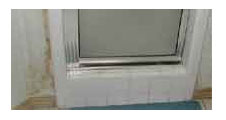|

Mold - A Growing Concern
AccuCheck Home Inspection Service uses patented, analytical,
methods, and state-of-the-art equipment to test for mold. These certified
testing methods assure accuracy and reliability.
Why test for mold in your home?
Medical studies have found that mold is the #1 cause of allergic symptoms.
The black mold, Stachybotrys, found in home, office and school environments
has been linked to fatal pulmonary disorders. This type of mold is thought
to be a possible cause of the sick building syndrome.
Types of Mold Inspections:
- Limited Mold Sampling - The purpose of a Limited
Mold Sampling is to detect the presence of mold contamination in client
defined areas of the home. this service provides a fast, economical
method of testing. The limitation of this service is that other sources
of mold may be present in the home.
- Mold Screen - This level of inspection utilizes a
visual assessment of the entire home, identifies "red flag"
areas for mold growth, and will have a limited sampling of mold. If
"red flags" are found, the client will be advised and offered
a chance for additional sampling. This service is the most popular inspection
service for real estate transactions.
- Mold Survey - The value of this service is that it
identifies, determines cause and then introduces corrective measures
for ALL mold sources discovered in the entire home. This service is
mainly used once a problem has been identified and remediation specifications
are needed.
What is Mold and Where Is It Found?
Molds are microscopic organisms, found virtually everywhere, indoors and
outdoors. Molds can be found on plants, foods, dry leaves, and other organic
material. Also susceptible to mold growth are cellulose materials, such
as, cardboard, paper, ceiling tiles, and sheet rock. Molds produce air-born
 spores
and gases and like moisture. They typically thrive in temperatures between
32 and 104 degrees Fahrenheit. (More
Facts About Mold) spores
and gases and like moisture. They typically thrive in temperatures between
32 and 104 degrees Fahrenheit. (More
Facts About Mold)
How Can Mold Affect Your Health?
Exposure to mold is not healthy for anyone but the following individuals
are at a higher risk for adverse health effects: infants, children, elderly,
immune compromised patients, pregnant women, and individuals with existing
respiratory conditions. When inhaled, even in small amounts, mold can
cause a wide range of health problems including respiratory problems (wheezing),
nasal and sinus congestion, watery and red eyes, nose and throat irritation,
skin irritation, aches and pains, fevers, asthma, emphysema and in some
cases even death. (Learn
more about Mold Allergy)
How Can You Be Exposed To Mold?
When moldy materials become damaged or disturbed, spores (reproductive
bodies similar to seeds) can be released into the air. The following are
sources of indoor moisture that may cause mold problems in your home or
office: flooding, leaky roofs, humidifiers, damp basements or crawl spaces,
constant plumbing leaks, house plants, steam from cooking, shower/bath
steam and leaks, wet clothes, and clothes dryers vented indoors.
(Got Mold? Frequently Asked Questions)
Why is mold more prevalent in homes today?
Homes today are built with heavier insulation, are “wrapped”
with a vapor barrier, have less outside air ventilation, and have improperly
vented fans and appliances. Also, wood products are not used as frequently
or kiln dried as effectively. (A
Brief Guide to Mold, Moisture and Your Home)
|





